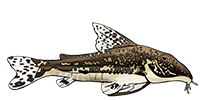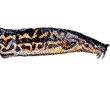jamesleagas wrote:id like any thoughts regarding sex if possible? thanks in advanced
jac wrote:For me they are all female. Just looking at headshape.
bekateen wrote:@jamesleagas, Can you try taking the same measurements on your fish in your photos and see if you can figure out the sexes using the information we've posted here?
Jac, since you have these fish, and you have a number of them, I'm inclined to trust your judgment on the sexes of jamesleagas' fish. But I couldn't wait - like a kid in a candy store - to see how jamesleagas' fish would come out if compared to the measurements and ratios I obtained from your fish.
Well, here are the results (see photos, each of the fish labeled 1-4), and Oh, this isn't good...

Jamesleagas, according to the morphometrics, all four fish shown in this photo come out clearly as males when head length, head width, and body width are measured and used to calculate the HW/HL ratio, snout angle, and the HW/BW ratio.
Both the HW/HL ratio and the snout angle are based on the same measurements, so we wouldn't expect them to disagree with each other, but the HW/BW ratio offers an independent way to check sex. Also, since the some of the fish have blackened heads, I couldn't make out eye position definitively, so I couldn't check this on 3 of the four fish, but on the one fish I could check (what I called fish #2 in my photo), the eyes are set wide apart, which is more like the males and less like jac's two "definitive females".
Jamesleagas, I don't know the ages of the fish in your photos but I can see from the ruler that your fish are only about half grown, so maybe your fish are just young and as a result their sexually dimorphic body proportions are not fully developed. Also, if you just got these fish from your LFS, the fish might be thinner because of suboptimal feeding at the store - this would have the effect of giving females a more male-like HW/BW ratio (i.e., females would be skinnier across the body, like males). If these factors are true, then this could explain the morphometrics diagnosing your fish as male, when in fact they could be females, as Jac said.
Jac, I don't wish to disagree with your assessment of the sexes of these fish. In fact, I trust your assessment more than my numbers. But alas, if we can infer anything from the body proportions of your six adults, then all four of these fish are males.

Jools wrote:I've seen species described with less difference.

I think this will be really useful, not just for Pseudohemiodon, in future.
Jools, if these four fish are females, then you can forget using the measurements I gave you earlier as a diagnostic tool!


Cheers, Eric
P.S.
Bekateen wrote:I've read that these fish change color with stress level (which I'm not surprised to learn; a lot of animals do). @Jac, I'm curious about the fact that both of your "males," as well as the only "male" labeled as such among the photos on the Pseudohemiodon apithanos page, are all black headed,
Well, if these are all males, then this photo shows a male that isn't black headed (although 3 out of 4 are - again, do males stress easier than females?). Cheers, Eric










